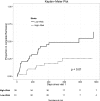Integrative Genomics Identifies Novel Associations with APOL1 Risk Genotypes in Black NEPTUNE Subjects
- PMID: 26150607
- PMCID: PMC4769193
- DOI: 10.1681/ASN.2014111131
Integrative Genomics Identifies Novel Associations with APOL1 Risk Genotypes in Black NEPTUNE Subjects
Abstract
APOL1 variants have been associated with renal phenotypes in blacks. To refine clinical outcomes and discover mechanisms of APOL1-associated kidney injury, we analyzed clinical and genomic datasets derived from 90 black subjects in the Nephrotic Syndrome Study Network (NEPTUNE), stratified by APOL1 risk genotype. Ninety subjects with proteinuria ≥0.5 g/d were enrolled at first biopsy for primary nephrotic syndrome and followed. Clinical outcomes were determined, and renal histomorphometry and sequencing of Mendelian nephrotic syndrome genes were performed. APOL1 variants were genotyped, and glomerular and tubulointerstitial transcriptomes from protocol renal biopsy cores were analyzed for differential and correlative gene expression. Analyses were performed under the recessive model (high-risk genotype defined by two risk alleles). APOL1 high-risk genotype was significantly associated with a 17 ml/min per 1.73 m(2) lower eGFR and a 69% reduction in the probability of complete remission at any time, independent of histologic diagnosis. Neither APOL1 risk group was enriched for Mendelian mutations. On renal biopsy, high-risk genotype was associated with increased fractional interstitial area, interstitial fibrosis, and tubular atrophy. Risk genotype was not associated with intrarenal APOL1 mRNA expression levels. Differential expression analysis demonstrated an increased steady-state level of five genes associated with the high-risk genotype (CXCL9, CXCL11, and UBD in glomerulus; SNOR14B and MUC13 in tubulointerstitium). APOL1 tubulointerstitial coexpression analysis showed coexpression of APOL1 mRNA levels with a group of intrarenal transcripts that together were associated with increased interstitial fibrosis and tubular atrophy. These data indicate the high-risk APOL1 genotype confers renal risk across histopathologic diagnoses.
Keywords: APOL1; epidemiology and outcomes; genetic renal disease; glomerular disease; nephrotic syndrome; transcriptional profiling.
Copyright © 2016 by the American Society of Nephrology.
Figures



References
-
- Genovese G, Friedman DJ, Ross MD, Lecordier L, Uzureau P, Freedman BI, Bowden DW, Langefeld CD, Oleksyk TK, Uscinski Knob AL, Bernhardy AJ, Hicks PJ, Nelson GW, Vanhollebeke B, Winkler CA, Kopp JB, Pays E, Pollak MR: Association of trypanolytic ApoL1 variants with kidney disease in African Americans. Science 329: 841–845, 2010 - PMC - PubMed
-
- Ito K, Bick AG, Flannick J, Friedman DJ, Genovese G, Parfenov MG, Depalma SR, Gupta N, Gabriel SB, Taylor HA, Jr, Fox ER, Newton-Cheh C, Kathiresan S, Hirschhorn JN, Altshuler DM, Pollak MR, Wilson JG, Seidman JG, Seidman C: Increased burden of cardiovascular disease in carriers of APOL1 genetic variants. Circ Res 114: 845–850, 2014 - PMC - PubMed
-
- Parsa A, Kao WH, Xie D, Astor BC, Li M, Hsu CY, Feldman HI, Parekh RS, Kusek JW, Greene TH, Fink JC, Anderson AH, Choi MJ, Wright JT, Jr, Lash JP, Freedman BI, Ojo A, Winkler CA, Raj DS, Kopp JB, He J, Jensvold NG, Tao K, Lipkowitz MS, Appel LJ, AASK Study Investigators. CRIC Study Investigators : APOL1 risk variants, race, and progression of chronic kidney disease. N Engl J Med 369: 2183–2196, 2013 - PMC - PubMed
-
- Tzur S, Rosset S, Skorecki K, Wasser WG: APOL1 allelic variants are associated with lower age of dialysis initiation and thereby increased dialysis vintage in African and Hispanic Americans with non-diabetic end-stage kidney disease. Nephrol Dial Transplant 27: 1498–1505, 2012 - PubMed
Publication types
MeSH terms
Substances
Grants and funding
LinkOut - more resources
Full Text Sources
Molecular Biology Databases
Research Materials
Miscellaneous

